
|
|
FYBUSH.COM/SITE OF THE WEEK
NEEDS YOUR SUPPORT! (AND YOU CAN GET A FREE TOWER SITE CALENDAR
IF YOU PLEDGE NOW...) CLICK HERE TO
LEARN MORE...
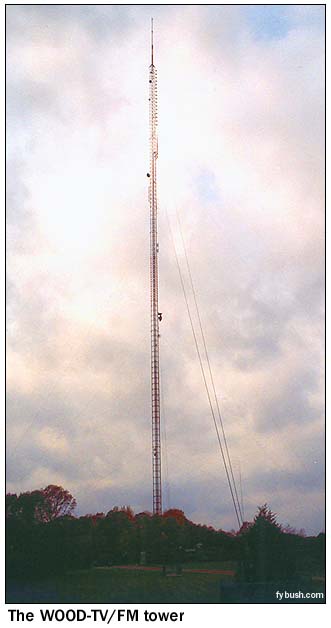 December 4-11, 2003
December 4-11, 2003
WOOD You Like To See More West Michigan?
OK, OK, I apologize for the bad pun. But it's hard to talk about Grand Rapids radio without mentioning the trio of stations that bear that famous call sign, and we're happy to share some photos of all three WOODs in this installment of Tower Site of the Week.
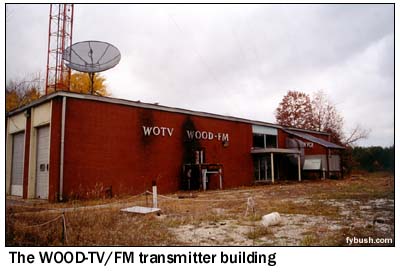
We'll start just north of the WWMT/WBCT site that we saw in last week's installment. Grand Rapids' WOOD-TV (Channel 8) built its tower halfway between Grand Rapids and Kalamazoo in the late fifties, spurring Kalamazoo's WKZO-TV to build the site near Gun Lake that we profiled last week. Today, this 973-foot tower holds channel 8's analog signal, WOOD-DT (Channel 7), which shares a new antenna with channel 8 after several years on low power from a side-mounted batwing on the tower, and WOOD-FM (105.7), the 265,000-watt grandfathered signal that's second only to WBCT (93.7) in power in this neck of the woods. WOOD-FM hasn't been a sister station to WOOD-TV in many years, though - the WOOD radio stations were sold separately from channel 8 in the early seventies, and channel 8 became WOTV for several decades before reclaiming the WOOD-TV calls, with WOOD radio's permission, in 1992. (The WOTV calls, still visible on the building above, went to channel 8's little sister station in Battle Creek, the former WUHQ on channel 41. WOTV dropped its own local newscasts last year and now simulcasts WOOD-TV's local news, albeit with ABC network programming instead of channel 8's NBC.)
Channel 8's reach from this tower has been reduced a bit in the last few years since DTV came on the scene. Milwaukee PBS outlet WMVS (Channel 10) was assigned channel 8 for its digital signal before the FCC realized how well those signals would propagate across open water. When WMVS-DT 8 signed on, viewers (and cable headends) on the eastern shore of Lake Michigan in places such as Muskegon and Holland lost their WOOD-TV signal whenever the trop was up over the lake; as a result, WOOD-TV now operates a translator under special temporary authority on channel 46 in Muskegon and an LPTV on channel 25 in Holland to relay its signal.
WOOD-FM is owned by Clear Channel these days and does AC as "Star 105.7." And, yes, that's a sixteen-bay antenna - well, sort of. It's actually two completely separate eight-bay antennas fed by separate feedlines and separate transmitters, thus allowing WOOD-FM to stay on the air at half power if work needs to be done on one of the transmission systems. Look carefully at the right side of the building and you can also see the WVGR calls - that's the public radio outlet that used this site until moving to the WWMT site a few years ago.
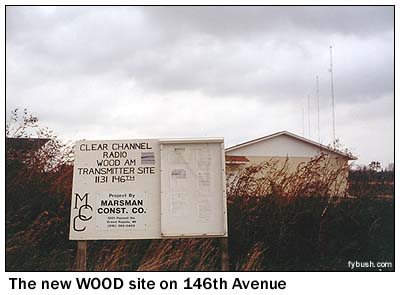 |
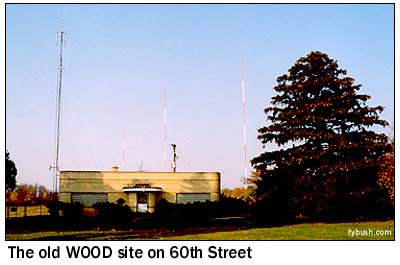 |
From the WOOD-TV/WOOD-FM site, we head east into Allegan County and then north a bit, to the newest transmitter site in West Michigan, at 1131 146th Avenue, west of US 131 and about 13 miles south of downtown Grand Rapids. These four towers are the new site for WOOD (1300), one of the region's oldest broadcasters. (The calls come from Furnwood Broadcasting, named in turn for the wooden furniture that made Grand Rapids famous; WFUR AM/FM likewise draws its calls from the Furniture City.)
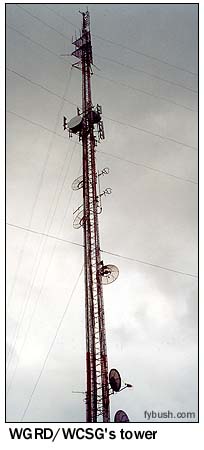
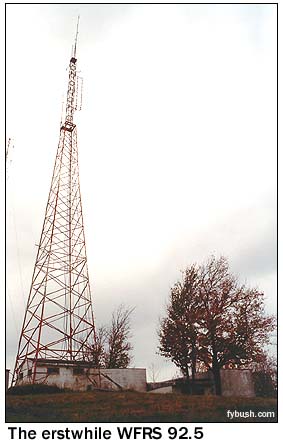 Since the early
1940s, WOOD's signal has come from a site seven miles north of
here, on 60th Street near Eastern Blvd., seen at right above.
This Art Deco building and the three towers out back pumped out
5000 watts of WOOD, non-directional by day, directional at night.
The center tower is slightly taller than the other two, I'm told,
because of a wartime shortage of steel - the station simply worked
with as much tower as it could get in 1942!
Since the early
1940s, WOOD's signal has come from a site seven miles north of
here, on 60th Street near Eastern Blvd., seen at right above.
This Art Deco building and the three towers out back pumped out
5000 watts of WOOD, non-directional by day, directional at night.
The center tower is slightly taller than the other two, I'm told,
because of a wartime shortage of steel - the station simply worked
with as much tower as it could get in 1942!
Encroaching residential development and a signal that no longer reached some of the outlying parts of the market compelled Clear Channel to leave this pretty site behind, though, and when we visited at the end of October the new site had just been turned on. From the four new towers, WOOD puts out 20 kilowatts, directional day and night, largely blasted north into Grand Rapids (though with a respectable lobe to the south along US 131 toward Kalamazoo as well.) WOOD bought and silenced WHGR (1290) in Houghton Lake to make this move possible.
From the new WOOD site, we head north across the line into Kent County, the highest point of which is a ridge that runs along 92nd Street east of US 131. It was there that another pioneering Grand Rapids station, WLAV (with calls standing for owner Leonard Adrian Verslius), signed on the region's first TV station, WLAV-TV 7, in 1949. (It would later move to channel 8 and become today's WOOD-TV.) WLAV-FM 96.9 signed on around the same time for those few folks with FM receivers - and was soon joined by an independent FM station, WFRS (92.5), just down the road.
Like so many early FM stations, WFRS soon fell silent, but its tower still stands, now used for ham repeaters and two-way communications. Right next door to the old WFRS tower is a tower that's used by two present-day Grand Rapids FM stations: rocker WGRD (97.9) and contemporary Christian WCSG (91.3), whose chief engineer, Tom Bosscher, is our host this day (as well as the proprietor of the excellent Michigan Broadcast Towers pages). That may look like a sizable transmitter building below, but both WCSG and WGRD share a small room behind the white door at the foot of the stairs, with the rest of the building used for non-broadcast purposes. I had to stand with my back against the corner of WGRD's transmitter to get even as much of WCSG's in the picture as I did! WGRD uses two bays at the very top of the tower; WCSG's four directional bays are right below WGRD's, and I'm afraid neither is very easy to see in this picture. (Visit Tom's page for some better ones - you can also see the old WCSG aux transmitter that's been replaced in this picture by a newer Harris.)
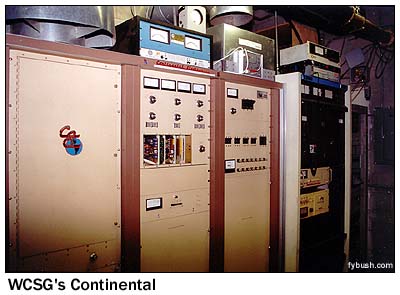 |
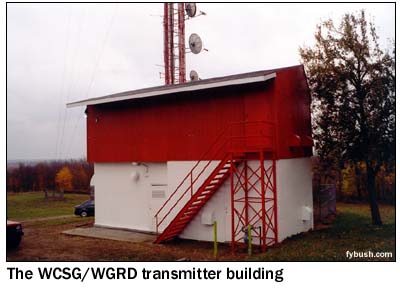 |
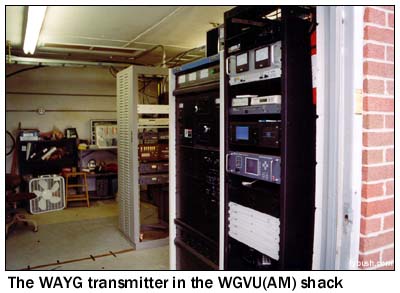 Our last stop (after
a late lunch) was at Tom's other site in Grand Rapids, Christian
hits WAYG (89.9), "Way FM."
Our last stop (after
a late lunch) was at Tom's other site in Grand Rapids, Christian
hits WAYG (89.9), "Way FM."
This little class A facility shares a transmitter site out on 68th Street east of Kalamazoo Avenue with public radio WGVU (1480), the descendant of the old WMAX radio, now owned by Grand Valley State University. WGVU's 5 kW BE transmitter is tucked behind the WAYG racks shown here; that's WAYG's Harris transmitter at the center of the picture. WAYG's antenna consists of two bays hung on one of the four WGVU towers, which I somehow missed photographing. (Again, check out Tom's site to see them, as well as the other pieces of both the WGVU broadcast empire - another AM, an FM and two TV stations - and WAYG's sister station in Kalamazoo, WAYK 88.3.)
We've just scratched the surface of West Michigan radio in our day of site visits here, of course, and we're looking forward to a good excuse to return and to check out some of the sites in Kalamazoo and Battle Creek, not to mention the rest of Grand Rapids. (A stop at Jerry Berta's Diner Land up in Rockford wouldn't hurt, either!)
But first, we've got more on the plate from our recent Midwest jaunt. Tune in next week as we begin exploring some fantastic sites in, around, and high above Chicago!
Tower Site Calendar 2004 ships THIS WEEK! Click here for advance ordering information!
- Previous Site of the Week: West Michigan, part 1
- Next Week: Chicago's WIND, WRTO and WOJO
- Site of the Week INDEX!
- How can you help support Site of the Week? Click here!
- Submit your suggestions for a future Site of the Week!
